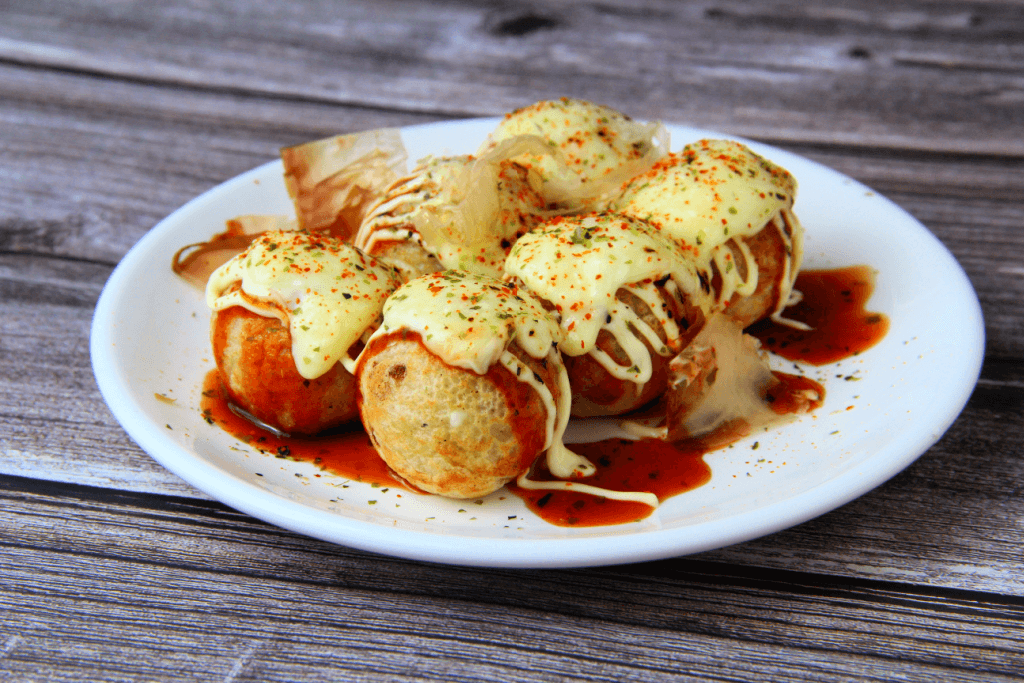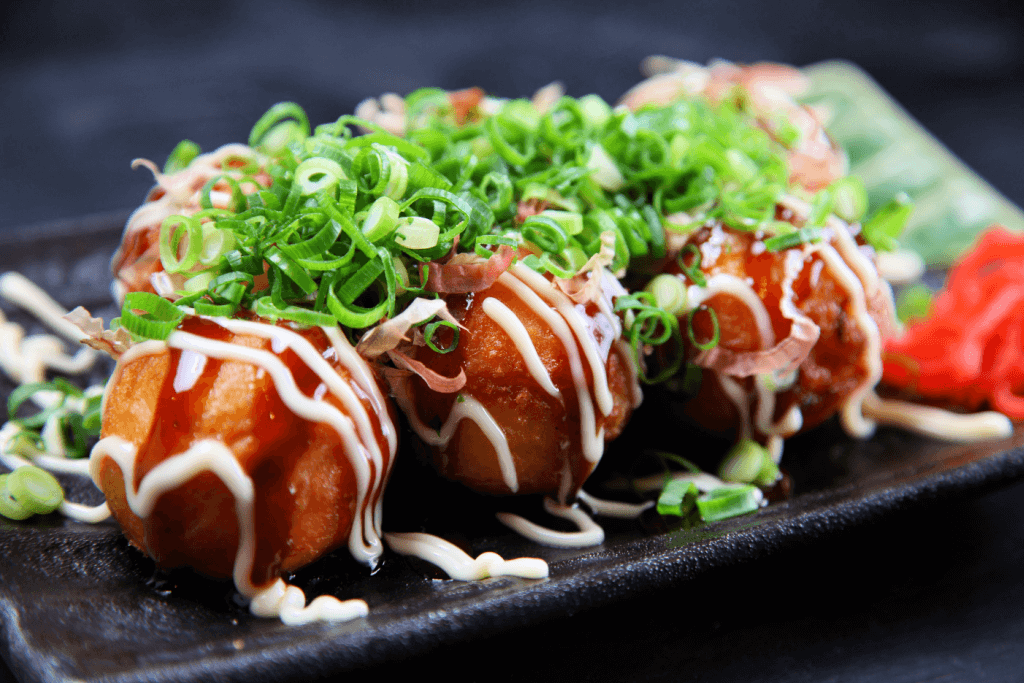History, osaka, takoyaki
Takoyaki Magic in Osaka: Embracing the Flavorful Tradition of Octopus Balls
James Lau
Posted on June 07, 2023
Share:

Takoyaki, a beloved Japanese street food, has captured food enthusiasts’ hearts and taste buds worldwide. These delectable octopus-filled balls, crispy on the outside and soft on the inside, offer a delightful burst of flavor. Let’s explore the fascinating story of takoyaki, from its humble beginnings to its current status as a global culinary sensation.
What is Takoyaki?
To make takoyaki–a savory snack made from a batter of flour, eggs, and dashi (a Japanese cooking stock)–people pour the batter into special takoyaki pans with half-spherical molds and fill them with small pieces of octopus, green onions, and pickled ginger. The snack is known as “octopus balls” in English.
Afterward, they carefully flip the ingredients using special takoyaki picks. This ensures a perfectly round shape for the takoyaki balls. Once cooked, people drizzle the takoyaki balls with takoyaki sauce, mayonnaise, bonito flakes, and seaweed powder to enhance their flavor and visual appeal.
How to Eat Takoyaki
Eating takoyaki is undoubtedly an experience because the piping hot octopus balls are traditionally served in a small paper boat, allowing easy consumption. Before taking a bite, it’s customary to sprinkle some additional toppings. Options include bonito flakes, seaweed powder, or chili powder. As a result, these toppings add an extra kick of flavor.

Be cautious, as the center of the takoyaki is often hotter than the outer layer. Take a small bite, savoring the combination of tender octopus, umami-rich batter, and the tangy sweetness of the sauce. Afterward, allow the flavors to dance on your palate as you enjoy the delightful contrast between the crispy exterior and the soft, gooey center.
The History of Takoyaki
The history of Takoyaki is intertwined with the vibrant streets of Osaka, Japan. It was in the early 1930s that Tomekichi Endo, a street vendor in Osaka‘s Umeda district, had a moment of culinary inspiration that would forever change the street food scene.

Generally, Endo experimented with a new method of cooking octopus, combining it with a batter made from flour, eggs, and dashi. First, he poured the batter into small half-spherical molds in a special pan and added tiny pieces of octopus, green onions, and pickled ginger. With skillful precision, he flipped the mixture using unique takoyaki picks to achieve perfectly rounded balls. The sizzling and tantalizing aroma drew curious passersby, and soon, a new snack was born—takoyaki.
Endo’s invention quickly gained popularity among the locals. The delicious combination of octopus and the unique texture of the batter made the snack an instant hit. Recognizing the snack’s potential, other street vendors in Osaka started replicating the dish, and takoyaki stalls began to dot the city’s bustling streets.
Are you looking for even more authentic Japanese snacks? Try Sakuraco! Sakuraco delivers traditional Japanese snacks, sweets, tableware, and more from local Japanese makers right to your door, perfect for a pleasant snack time at home!
How did octopus balls become popular?
As the popularity of takoyaki grew, so did the variety of fillings and toppings. Eventually, vendors experimented with different ingredients to create their signature dish versions. Some introduced unconventional fillings like cheese, shrimp, or vegetables, adding new dimensions to the traditional dish. This creative spirit contributed to its evolution, making it even more appealing to a broader audience.

Throughout the years, this savory delicacy remained a staple street food in Osaka. Eventually, the city became synonymous with the snack, and visitors flocked to taste the authentic, mouthwatering octopus balls. Takoyaki stalls became iconic landmarks, with their sizzling pans and fragrant aromas filling the air.
Its popularity extended beyond Osaka’s borders and spread to other parts of Japan. As the snack gained traction, dedicated shops emerged, further solidifying its status as a beloved culinary treasure. These specialized shops offered an array of fillings and toppings, catering to the diverse preferences of takoyaki enthusiasts.
What are octopus balls like today?
In recent years, takoyaki’s popularity has transcended cultural boundaries, reaching international markets. More specifically, Japanese restaurants worldwide have embraced takoyaki, introducing it as a must-try item on their menus. To emphasize, the unique combination of flavors, the interactive cooking process, and the visually appealing presentation have made it a favorite among diners seeking an authentic taste of Japan.
Presently, takoyaki festivals are held throughout Japan, with Osaka hosting some of the most vibrant celebrations. These festivals undoubtedly showcase the best vendors, each offering their interpretations and variations of the classic snack. For that reason, visitors can sample a wide range of creations, from traditional flavors to innovative and daring combinations, making the festivals a culinary adventure in their own right.

The legacy of takoyaki extends beyond its gastronomic appeal. It has become a symbol of Japanese street food culture and a testament to the creativity and passion of its creators. Their special griddles, once a practical tool for street vendors, have become sought-after kitchen utensils worldwide for cooking enthusiasts.
All in all, the story of Takoyaki is a tale of culinary ingenuity and cultural significance. From its humble beginnings as an experiment in a street vendor’s pan to its current status as a global sensation, this dish has captured people’s hearts and taste buds worldwide. To put it another way, its journey is a testament to the power of a simple idea transformed into a beloved and iconic dish. Have you ever tried takoyaki? Did you eat the traditional versions or a new style? Let us know in the comments below!

Discover authentic flavors with Sakuraco
Get Sakuraco 

Discover authentic flavors with Sakuraco
Get Sakuraco 
Related Articles

Tonkatsu Luxury Restaurants: Best Ones to Try!
Don’t miss out on tonkatsu if you’re traveling to Japan! Tourists often add the meal to their must-eat list because of its delicious and satisfying nature. Even better, you can elevate the experience by going to luxury restaurants across Japan, where you can experience some of the most celebrated pork cutlets.

Mochi: How is Mochitsuki Made in Japan?
Mochitsuki is the Japanese tradition of pounding steamed rice to make mochi for the New Year. Families and neighbors gather to participate in this lively and meaningful tradition. The teamwork involved helps everyone feel a sense of connection.

Konpeito Candy: What Makes This Starry Treat Shine?
If you are a fan of the famous Demon Slayer series, then you probably know that the favorite treat of the adorable Nezuko Kamado is those tiny, colorful little sweets.

Kinako: The Amazing Roasted Soybean Powder!
Kinako is a very popular ingredient that can easily be found in many traditional Japanese sweets. It has a distinctive flavor, standing alongside other classic tastes such as red bean or sesame. Let’s explore this charming ingredient together, and who knows, you might even be able to make it in your own beloved kitchen!



